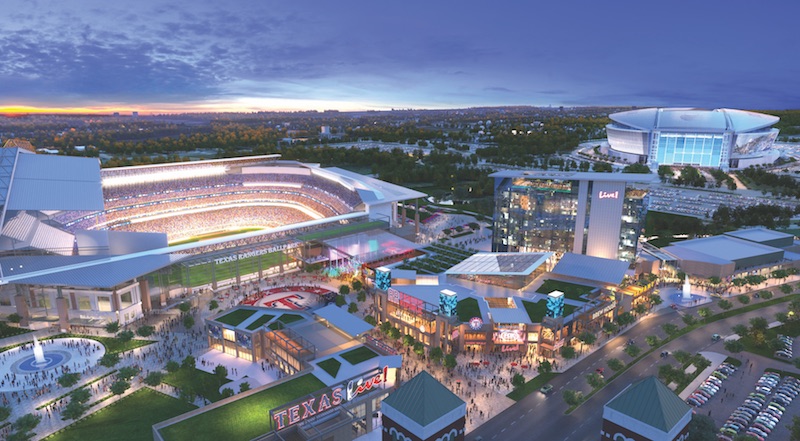The Irving (Texas) Music Factory, a 17-acre entertainment district anchored by a 103,620-sf, 8,000-seat-capacity pavilion, was scheduled to open August 31, with no less a headliner than comedian Dave Chappelle. The entertainment district encompasses 25 restaurants and bars, a 35,000-sf Alamo Drafthouse cineplex, and 100,000 sf of office space that Ethos Group, a financial consultant, is leasing.
ARK Group, the developer of the $173 million project, is hoping to duplicate the success of its nine-acre entertainment district in Charlotte, N.C., which opened in 2009 inside a converted textile mill. That district, now called AvidXchange Music Factory, has more than 15 restaurants, bars, and performance spaces, including a 5,000-seat amphitheater and 2,000-seat music hall. It drew 1.8 million visitors in 2016.
AvidXchange, an accounts-payable service provider that is this entertainment district’s exclusive sponsor, recently moved 1,000 employees into its new 200,000-sf, six-story headquarters in the district. Within walking distance, ARK and Woodfield Investments are putting the finishing touches on the $20.8 million, 205-unit Cadence Music Factory Apartments that is scheduled to open this fall.
Entertainment districts are being planned or are popping up all over the country. While they vary in size, building type, and tenant mix, the collective intent of developers and municipalities is clear: to rejuvenate exhausted or neglected real estate, to generate much-needed tax revenues, and to bolster their cities’ live-work-play image as they compete fiercely with other metros for businesses and residents.
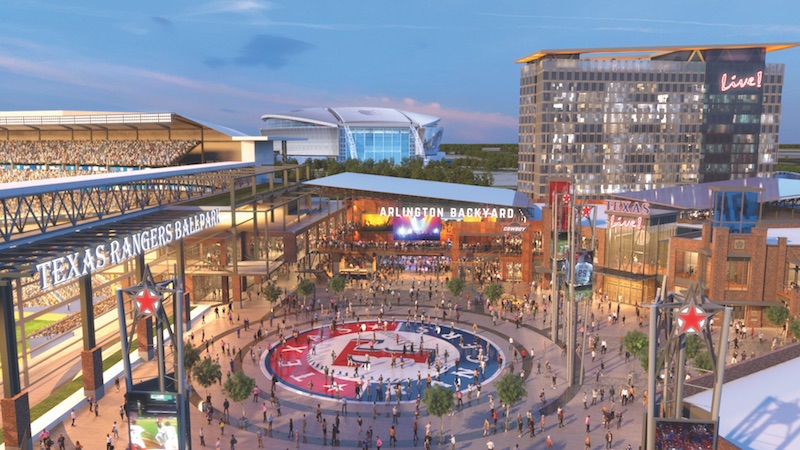 Texas Live! is expected to generate $100 million in economic output annually for the city of Arlington and Tarrant County. Rendering courtesy of The Cordish Companies.
Texas Live! is expected to generate $100 million in economic output annually for the city of Arlington and Tarrant County. Rendering courtesy of The Cordish Companies.
Public and private supporters view entertainment districts as potential catalysts for broader urban redevelopment and growth that, in many cases, is abetted by parallel investments in mass transit to expand the district’s reach beyond its immediate boundaries.
“Our entertainment districts become central gathering places in their cities,” says Zed Smith, Chief Operating Officer of Baltimore-based The Cordish Companies, a leading developer whose districts—which include trendsetters Fourth Street Live! in Louisville, Ky., and the Power & Light District in Kansas City, Mo.—welcome more than 50 million visitors a year. “They give cities a heartbeat, become major drivers of economic development for their communities, and provide thousands of jobs to the region.”
LEGAL RELIEF HELPS PAVE THE WAY
Mayor William Bell of Birmingham, Ala., sees potential for his city to create four more entertainment districts. Why not? There’s been plenty of activity around Birmingham’s first district, Uptown, which the city approved four years ago.
A $300 million master plan for the Birmingham–Jefferson Convention Complex, proposed by Populous, calls for a 45,000- to 55,000-seat stadium to be built just north of Uptown. Under construction on a 10-acre property across the street from the district is a three-level Top Golf driving range. The 65,000-sf facility is projected to serve 450,000 visitors in its first year, create 500 jobs, and generate $264.5 million in economic impact over 10 years.
“Entertainment districts are juggernauts, and they are serving the same function that town centers did years ago,” says Matt Billerbeck, AIA, Senior Vice President and Sector Leader for Shopping and Entertainment Districts with CallisonRTKL, which has designed several districts for the developer AEG.
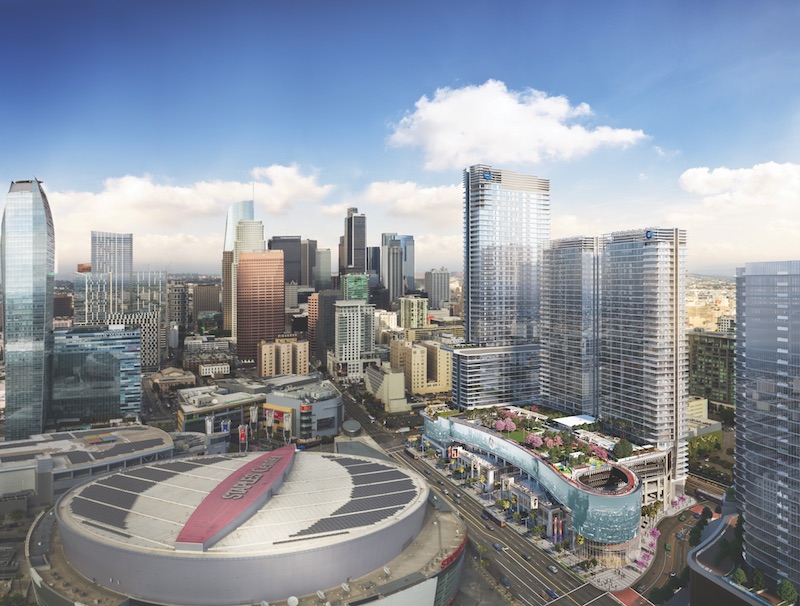 The 1.5-million-sf Oceanwide Plaza, going up across the street from Staples Center and L.A. Live, will include a “lifestyle plaza,” 100 feet in the air, with 37,000 sf of outdoor amenity spaces. A 700-foot-long LED ribbon will wrap the plaza. And this mixed-use project will feature a 166,580-sf open-air retail galleria. CallisonRTKL designed the exterior, retail interior, and South Towers residential space. Rendering courtesy of Oceanwide Plaza/CallisonRTKL.
The 1.5-million-sf Oceanwide Plaza, going up across the street from Staples Center and L.A. Live, will include a “lifestyle plaza,” 100 feet in the air, with 37,000 sf of outdoor amenity spaces. A 700-foot-long LED ribbon will wrap the plaza. And this mixed-use project will feature a 166,580-sf open-air retail galleria. CallisonRTKL designed the exterior, retail interior, and South Towers residential space. Rendering courtesy of Oceanwide Plaza/CallisonRTKL.
City leaders around the country are relaxing land use, noise restriction, and open-container laws that can slow or kill approval of an entertainment district plan.
Last January, the Omaha, Neb., City Council voted unanimously to allow outdoor drinking in entertainment districts. The new ordinance allows a seemingly conventional mixed-use development under construction—The Capitol District—to be positioned as an entertainment district.
Once a parking lot, the 5.4-acre Capitol District will connect the city’s central business district to the west, its Old Market District, and its Events District, which includes the convention center and the stadium where the College Baseball World Series is played each year.
The $205 million Capitol District project, developed by Shamrock Development, opened this summer with a 218-unit modular apartment building designed and engineered by Prescient and built by MCL Construction. The 333-room Omaha Marriott Downtown, designed by Leo A Daly (which master planned the district) and built by JE Dunn, also came on line this summer. A third, retail-focused building is set to open next spring.
The Capitol District will eventually offer 20 restaurants, an outdoor plaza with a performance stage, an ice-skating rink, and side streets programmed for festivals and other activities.
SPORTS COMPONENT—NICE TO HAVE, BUT NOT STRICTLY ESSENTIAL
One thing that separates entertainment districts from lifestyle centers or theme parks is that “everything is choreographed and curated,” says Ian Zapata, AIA, LEED AP, Senior Associate and Design Director in the Dallas office of Gensler, the design architect for Irving Music Factory.
According to Zapata and his colleagues Barry Hand, AIA, LEED AP BD+C, Principal and Studio Leader; and Shannon Bearden, AIA, NCARB, LEED AP, Associate and Project Architect, successful districts must have “something for everyone” and have to be “authentic” to their locales.
The term “entertainment district” has become shorthand for a variety of locations that, in different markets, revolve around sports, live performances, amusements and exhibits, food and beverage (“huge,” says Billerbeck), or some combination thereof.
A common success measure is whether an entertainment district gives visitors reasons to stay longer and to return frequently. “Variety is the key,” says Cordish’s Smith, “whether it’s a cultural activity, an art show, regional or national concerts, charitable functions, or community and family events.”
Some of the more high-profile entertainment districts are matched with sports arenas or stadiums. Titletown District, the 34-acre, $130 million district near Lambeau Field in Green Bay, Wis., is unique, in that it sets aside more than eight acres for open space and parks. Phase One—which includes a hotel, brewery, and sports clinic—has opened, and the park and plaza are scheduled to open this month.
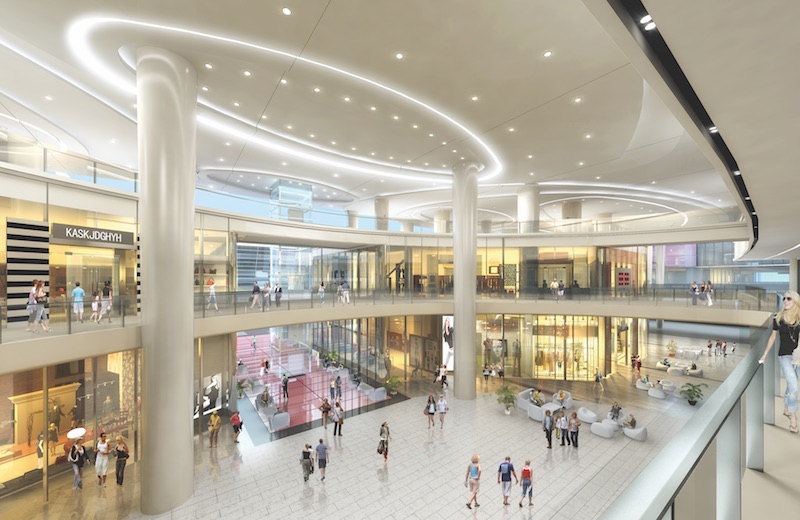 Rendering courtesy of Oceanwide Plaza/CallisonRTKL.
Rendering courtesy of Oceanwide Plaza/CallisonRTKL.
Next year, Cordish will open Texas Live!, a $250 million, 200,000-sf venue that’s part of a $4 billion master plan for the Arlington Entertainment District, which includes a new $1 billion baseball stadium for the Texas Rangers, an investor in the district. When completed, the district—which straddles the Dallas Cowboys’ 100,000-seat AT&T Stadium—will offer a 300-key Loew’s hotel, a 5,000-seat outdoor events pavilion, and 35,000 sf of meeting/convention space.
But a sports link isn’t absolutely essential for an entertainment district to thrive. The 350,000-sf Fourth Street Live!, which opened in 2004, is still kicking with its mix of restaurants, bars, a brewery, retail, and live-music clubs. The same is true of the six districts in Austin, Texas, home to the popular South by Southwest music, film, and tech festival.
In Charlotte, developer Cambridge Properties is in the process of getting 34 acres rezoned for the University City Entertainment District, near the UNC Charlotte campus. The proposed district would feature a nine-screen cineplex with a full bar, restaurant, and brewery, plus a hotel, bowling alley, and rooftop bar with views of the city. According to Jay Priester, Jr., Cambridge’s Vice President of Leasing and Development, the company is also trying to lure Top Golf and iFly, the indoor skydiving venue, as tenants.
Priester says that, if all goes as planned, construction could begin within 24 months on the adaptive reuse of an existing 100,000-sf industrial building. Architecture/engineering firm Land Design is doing the master plan and providing rezoning advice. University City should benefit from its location near two highways and a light-rail station stop, says Priester.
PLAYING OFF ORLANDO’S CONVENTION CENTER
Priester envisions University City as something akin to I-Drive 360 in Orlando, Fla., a prime example of an amusements- and exhibits-oriented entertainment district.
The $250 million I-Drive 360 opened in 2015 on 18 acres along International Drive that were occupied by a failed retail/dining venture. The district offers a range of eateries, bars, and a $1.5 million water show set to music. Its 30-plus tenants include Madame Tussauds, SEA Life Aquarium, and Skeletons: Animals Unveiled!, an animal bones museum.
The focal point of I-Drive 360 is its 400-foot-tall Coca-Cola Orlando Eye Ferris wheel, whose 15 air-conditioned capsules carry up to 30 people each.
Eleven-mile-long International Drive has emerged as one of the country’s robust redevelopment areas, helping to make Orange County, Fla., the No. 1 convention destination in the U.S. I-Drive 360 alone draws more than two million visitors a year. International Drive runs perpendicular to Universal Boulevard, where “significant development” is occurring as well, says John Stine, I-Drive 360’s Marketing Manager.
Two other ride-centric venues are in the offing on land adjacent to I-Drive 360: the 14-acre, $300 million Skyplex which, when it opens in 2020, could include Skyscraper, the world’s tallest roller coaster (570 feet); and Vue at 360, a nine-acre plaza that will feature SkyFlyer, which at 425 feet would be the world’s tallest swing ride.
“We are sitting in a prime area,” says Rosemary Rose, I-Drive 360’s CEO.
OLDER DISTRICTS STAND THE TEST OF TIME
Developers that pitch entertainment districts to cities can point to any number of older districts that not only have demonstrated staying power, but also have been springboards for redevelopment and new construction.
Two of these—Kansas City Power & Light District and L.A. Live—celebrate their 10th anniversaries this year.
The Kansas City Power & Light District’s tax revenues still don’t cover its debt service and fees. But much of the $295 million in city-backed bonds that Kansas City issued to support this district have gone toward improving infrastructure like streets, garages, and sewers. That investment continues to pay dividends.
More than $2 billion in economic development activity is under way in Kansas City’s downtown, led by the $311 million, 800-room Loew’s Convention Hotel, which is scheduled to break ground later this year. In its “2017 Kansas City Downtown Development Report,” CBRE notes that 2,287 residential units have been completed downtown since 2014. Another 2,885 units under construction will be completed over the next two years, including Two Light, a $120 million, 24-story tower. Amenities include the largest installation of Smart City technology in the country.
Downtown KC is “once again becoming a preferred corporate location,” CBRE concluded in its report.
Speaking for City Manager Troy Schulte, city official Chris Hernandez credits “the original spark for downtown development” with the city’s “bold decision” in 2005 to build a city-owned, 19,000-seat arena (now called the Sprint Center) and to approve incentives for the privately owned Power & Light entertainment district across the street.
The arena never got an NHL or NBA team, but it’s regularly booked with NCAA basketball games, an Arena Football League team, and concerts and other events.
To lure the Los Angeles Lakers franchise from its longtime home in Inglewood, Calif., city officials in Los Angeles condemned 25 acres around the convention center to make way for the 21,000-seat Staples Center arena, which opened in 1999, and the entertainment district L.A. Live, which debuted eight years later. The public-private investment in Staples and L.A. Live was about $4 billion.
L.A. Live now attracts 15-16 million visitors a year, according to Ted Tanner, Senior Vice President of Anschutz Entertainment Group (AEG), the developer of Staples Center and L.A. Live. The 5.6-million-sf district hosts 20-plus food tenants, three clubs, the 7,100-seat Microsoft Theater, ESPN’s broadcasting studio, a 100,000-sf Regal cineplex that alone draws nearly a million moviegoers a year, two hotels with more than a thousand rooms, and 170,000 sf of office space. Black Entertainment Television holds its annual awards ceremony there.
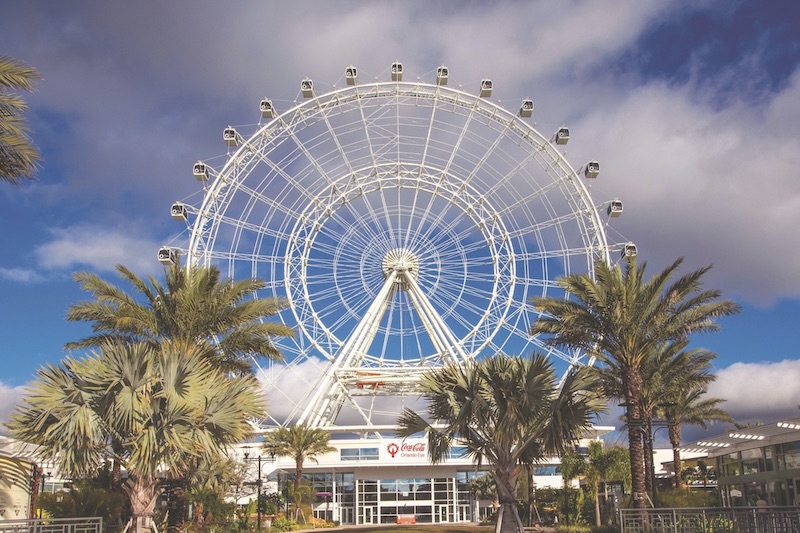 Two focal points of I-Drive 360 in Orlando, Fla., an amusements-oriented entertainment district, are the $90 million, 400-foot-tall Coca-Cola Orlando Eye Ferris wheel, and a $1.5 million waterfall feature that’s set to music. Photo courtesy of I-Drive 360.
Two focal points of I-Drive 360 in Orlando, Fla., an amusements-oriented entertainment district, are the $90 million, 400-foot-tall Coca-Cola Orlando Eye Ferris wheel, and a $1.5 million waterfall feature that’s set to music. Photo courtesy of I-Drive 360.
AEG also purchased more than 20 contiguous acres in downtown’s South Park area, which it has been selling to other developers. Today, $14.5 billion in construction is situated or being built on land that AEG entitled, according to CFO Michael Roth.
Recent construction includes two major mixed-used residential projects, both being built by Lendlease: Circa, whose two 34-story towers will offer 648 apartments and 48,000 sf of retail; and the $1 billion, three-tower Oceanwide Plaza, with 504 condos, 153,000 sf of retail, and 183 hotel rooms (under the Hyatt banner).
“The principals involved concluded that L.A. Live would become an even greater space with residential/hotel that would make it a 24-hour environment,” says Daun St. Amand, LEED AP BD+C, Senior Vice President at CallisonRTKL’s Los Angeles office, which designed Oceanwide. “You’re always trying to extend the hours of the entertainment district.”
NEW MARKETS, NEW BUSINESS NEEDS
As entertainment districts multiply and incorporate new elements, developers and their AEC partners are looking for ways to massage the concept to meet the economic needs of more communities.
AEG has been discussing internally how it can scale its entertainment districts for different-sized metros. To test its theories, it has purchased four acres on the 15-acre Nashville Yards redevelopment in Tennessee for an entertainment district that Tanner says will squeeze in two music venues, a nine-screen cineplex, a bowling alley, a boutique hotel with 200-250 rooms, and up to a dozen food and beverage tenants.
In May, Cordish revealed that Spark Baltimore, the flagship coworking space at its Power Plant district within Baltimore’s Inner Harbor, would open a second coworking space at Cordish’s Fourth Street Live! in Louisville. Cordish is closing two clubs to make room for the 20,000-sf incubator, which is expected to open next year and offer entrepreneurs and innovators a different twist on live, work, and play.
Related Stories
| Mar 9, 2011
Igor Krnajski, SVP with Denihan Hospitality Group, on hotel construction and understanding the industry
Igor Krnajski, SVP for Design and Construction with Denihan Hospitality Group, New York, N.Y., on the state of hotel construction, understanding the hotel operators’ mindset, and where the work is.
| Feb 15, 2011
Iconic TWA terminal may reopen as a boutique hotel
The Port Authority of New York and New Jersey hopes to squeeze a hotel with about 150 rooms in the space between the old TWA terminal and the new JetBlue building. The old TWA terminal would serve as an entry to the hotel and hotel lobby, which would also contain restaurants and shops.
| Feb 11, 2011
Kentucky’s first green adaptive reuse project earns Platinum
(FER) studio, Inglewood, Calif., converted a 115-year-old former dry goods store in Louisville, Ky., into a 10,175-sf mixed-use commercial building earned LEED Platinum and holds the distinction of being the state’s first adaptive reuse project to earn any LEED rating. The facility, located in the East Market District, houses a gallery, event space, offices, conference space, and a restaurant. Sustainable elements that helped the building reach its top LEED rating include xeriscaping, a green roof, rainwater collection and reuse, 12 geothermal wells, 81 solar panels, a 1,100-gallon ice storage system (off-grid energy efficiency is 68%) and the reuse and recycling of construction materials. Local firm Peters Construction served as GC.
| Jan 25, 2011
AIA reports: Hotels, retail to lead U.S. construction recovery
U.S. nonresidential construction activity will decline this year but recover in 2012, led by hotel and retail sectors, according to a twice-yearly forecast by the American Institute of Architects. Overall nonresidential construction spending is expected to fall by 2% this year before rising by 5% in 2012, adjusted for inflation. The projected decline marks a deteriorating outlook compared to the prior survey in July 2010, when a 2011 recovery was expected.
| Jan 19, 2011
San Diego casino renovations upgrade gaming and entertainment
The Sycuan Casino in San Diego will get an update with a $27 million, 245,000-sf renovation. Hnedak Bobo Group, Memphis, Tenn., and Cleo Design, Las Vegas, drew design inspiration from the historic culture of the Sycuan tribe and the desert landscape, creating a more open space with better circulation. Renovation highlights include a new “waterless” water entry feature and new sports bar and grill, plus updates to gaming, poker, off-track-betting, retail, and bingo areas. The local office of San Francisco-based Swinerton Builders will provide construction services.
| Dec 17, 2010
Vietnam business center will combine office and residential space
The 300,000-sm VietinBank Business Center in Hanoi, Vietnam, designed by Foster + Partners, will have two commercial towers: the first, a 68-story, 362-meter office tower for the international headquarters of VietinBank; the second, a five-star hotel, spa, and serviced apartments. A seven-story podium with conference facilities, retail space, restaurants, and rooftop garden will connect the two towers. Eco-friendly features include using recycled heat from the center’s power plant to provide hot water, and installing water features and plants to improve indoor air quality. Turner Construction Co. is the general contractor.
| Dec 17, 2010
Toronto church converted for condos and shopping
Reserve Properties is transforming a 20th-century church into Bellefair Kew Beach Residences, a residential/retail complex in The Beach neighborhood of Toronto. Local architecture firm RAWdesign adapted the late Gothic-style church into a five-story condominium with 23 one- and two-bedroom units, including two-story penthouse suites. Six three-story townhouses also will be incorporated. The project will afford residents views of nearby Kew Gardens and Lake Ontario. One façade of the church was updated for retail shops.
| Dec 2, 2010
GKV Architects wins best guest room design award for Park Hyatt Istanbul
Gerner Kronick + Valcarcel, Architects, PC won the prestigious Gold Key Award for Excellence in Hospitality Design for best guest room, Park Hyatt Macka Palas, Istanbul, Turkey. Park Hyatt Maçka Palace marries historic and exotic elements with modern and luxurious, creating a unique space perpetuating Istanbul’s current culture. In addition to the façade restoration, GKV Architects designed 85 guestrooms, five penthouse suites, an ultra-hip rooftop bar, and a first-of-its-kind for Istanbul – a steakhouse, for the luxury hotel.
| Nov 16, 2010
CityCenter’s new Harmon Hotel targeted for demolition
MGM Resorts officials want to demolish the unopened 27-story Harmon Hotel—one of the main components of its brand new $8.5 billion CityCenter development in Las Vegas. In 2008, inspectors found structural work on the Harmon didn’t match building plans submitted to the county, with construction issues focused on improperly placed steel reinforcing bar. In January 2009, MGM scrapped the building’s 200 condo units on the upper floors and stopped the tower at 27 stories, focusing on the Harmon having just 400 hotel rooms. With the Lord Norman Foster-designed building mired in litigation, construction has since been halted on the interior, and the blue-glass tower is essentially a 27-story empty shell.
| Nov 3, 2010
Rotating atriums give Riyadh’s first Hilton an unusual twist
Goettsch Partners, in collaboration with Omrania & Associates (architect of record) and David Wrenn Interiors (interior designer), is serving as design architect for the five-star, 900-key Hilton Riyadh.


